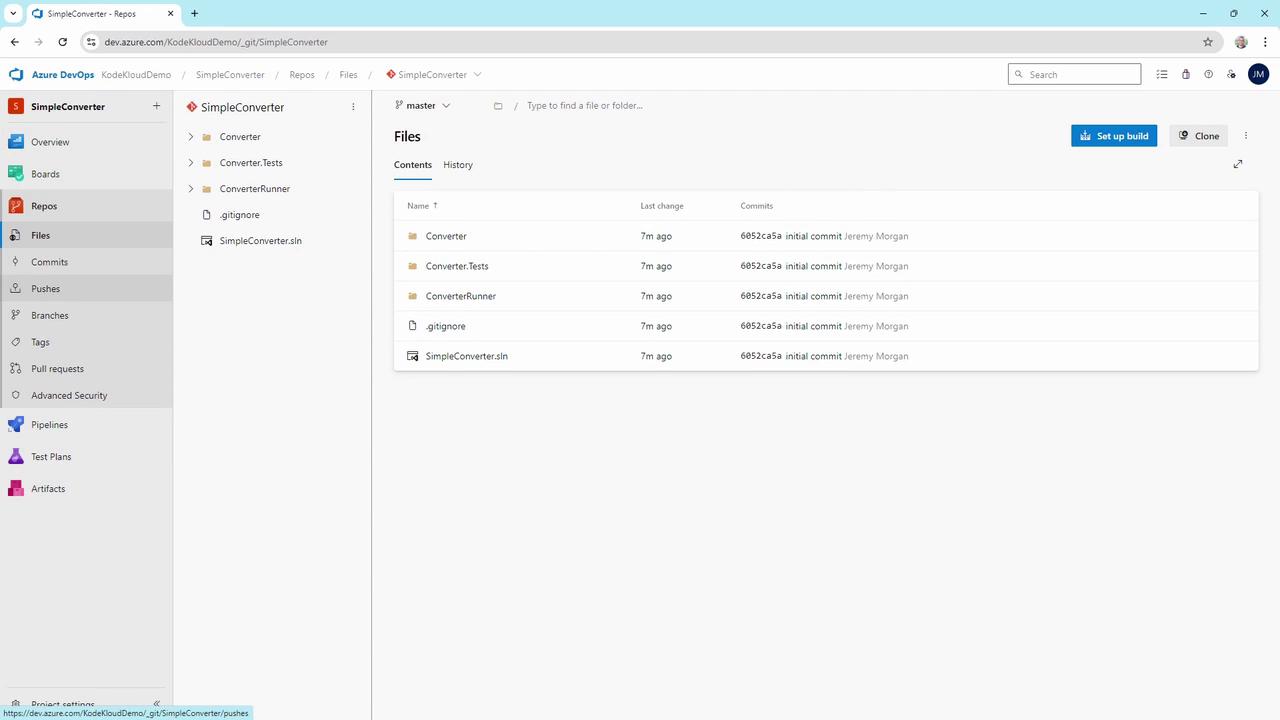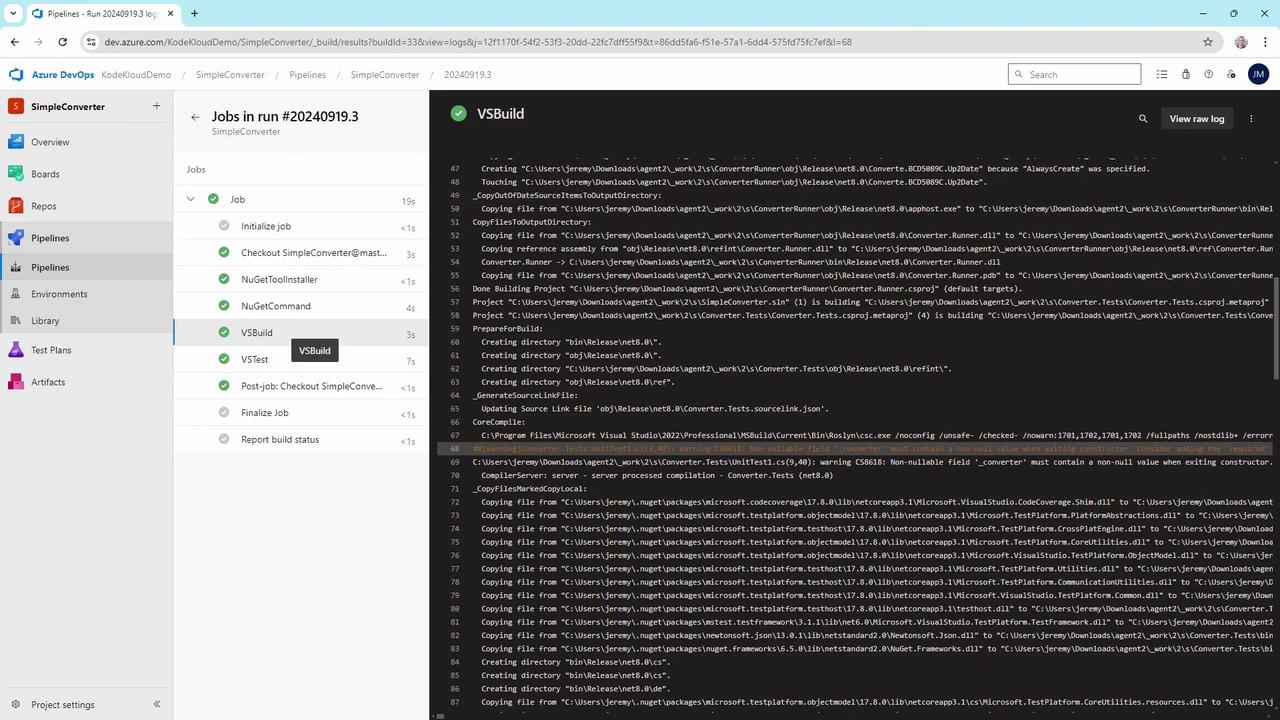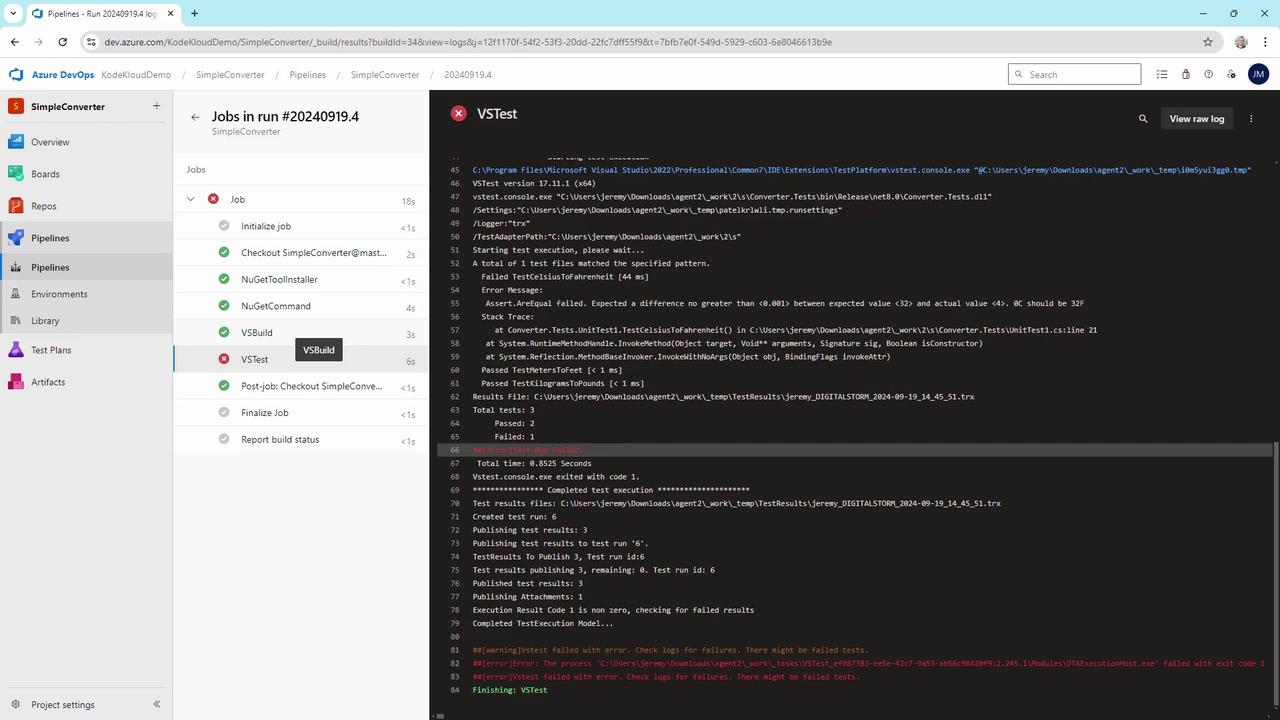AZ-400: Designing and Implementing Microsoft DevOps Solutions
Design and Implement Pipeline Automation
Integration of automated tests into pipelines
In this guide, you’ll learn how to integrate MSTest-based automated tests into an Azure DevOps pipeline for a simple C# application. By enforcing tests in CI, every code change is verified and any failures block deployment before reaching production.
Converter Class Library
We start with a basic C# class library containing conversion methods:
namespace ConverterLib
{
public class Converter
{
public double CelsiusToFahrenheit(double celsius)
{
return (celsius * (9.0 / 5.0)) + 32;
}
public double MetersToFeet(double meters)
{
return meters * 3.28004;
}
public double KilogramsToPounds(double kilograms)
{
return kilograms * 2.20462;
}
}
}
You can verify outputs locally with a small console runner.
Conversion Methods at a Glance
| Conversion | Method Signature | Formula |
|---|---|---|
| Celsius → Fahrenheit | double CelsiusToFahrenheit(double) | (celsius * 9/5) + 32 |
| Meters → Feet | double MetersToFeet(double) | meters * 3.28004 |
| Kilograms → Pounds | double KilogramsToPounds(double) | kilograms * 2.20462 |
Setting Up the Azure DevOps Pipeline
In Azure DevOps, select Azure Repos Git as the source and point to the SimpleConverter repository:

Choose the .NET Desktop template to match our class library:

Here’s the initial azure-pipelines.yml for CI:
trigger:
- master
pool:
vmImage: 'windows-latest'
variables:
solution: '**/*.sln'
buildPlatform: 'Any CPU'
buildConfiguration: 'Release'
steps:
- task: NuGetToolInstaller@1
- task: NuGetCommand@2
inputs:
restoreSolution: '$(solution)'
- task: VSBuild@1
inputs:
solution: '$(solution)'
platform: '$(buildPlatform)'
configuration: '$(buildConfiguration)'
- task: VSTest@2
inputs:
platform: '$(buildPlatform)'
configuration: '$(buildConfiguration)'
After committing, the pipeline runs successfully:

Pipeline Task Overview
| Task | Purpose | YAML Snippet |
|---|---|---|
| NuGetToolInstaller@1 | Installs NuGet CLI | - task: NuGetToolInstaller@1 |
| NuGetCommand@2 | Restores NuGet packages | - task: NuGetCommand@2 |
| VSBuild@1 | Builds the solution | - task: VSBuild@1 |
| VSTest@2 | Runs unit tests | - task: VSTest@2 |
Adding MSTest Unit Tests
Create a new MSTest project that references ConverterLib. Here’s a complete test class:
using ConverterLib;
using Microsoft.VisualStudio.TestTools.UnitTesting;
namespace Converter.Tests
{
[TestClass]
public class ConverterTests
{
private Converter _converter;
[TestInitialize]
public void Setup()
{
_converter = new Converter();
}
[TestMethod]
public void TestCelsiusToFahrenheit()
{
Assert.AreEqual(32, _converter.CelsiusToFahrenheit(0), 0.001, "0°C should be 32°F");
Assert.AreEqual(212, _converter.CelsiusToFahrenheit(100), 0.001, "100°C should be 212°F");
}
[TestMethod]
public void TestMetersToFeet()
{
Assert.AreEqual(3.28084, _converter.MetersToFeet(1), 0.00001, "1 meter ≈ 3.28084 feet");
}
[TestMethod]
public void TestKilogramsToPounds()
{
Assert.AreEqual(22.0462, _converter.KilogramsToPounds(10), 0.001, "10 kg ≈ 22.0462 lb");
}
}
}
Run the tests locally to confirm they pass, then commit and push. The pipeline’s VSTest task will verify them in CI.
Demonstrating a Pipeline Failure
Introduce a faulty implementation for demonstration:
public double CelsiusToFahrenheit(double celsius)
{
// Faulty return for demonstration
return 4;
// return (celsius * (9.0 / 5.0)) + 32;
}
A local build succeeds, but the console runner shows incorrect output:
Hello, World!
The temperature is 30 degrees, or 4 degrees Fahrenheit
When pushed, the VSTest step fails in Azure DevOps:

This enforcement blocks deployment until the logic error is fixed.
Warning
Never omit the VSTest task in your pipeline. Without it, logic errors slip through and can reach production.
Avoiding Accidental Omissions
A pipeline without tests might look like:
trigger:
- master
pool:
vmImage: 'windows-latest'
variables:
solution: '**/*.sln'
buildPlatform: 'Any CPU'
buildConfiguration: 'Release'
steps:
- task: NuGetToolInstaller@1
- task: NuGetCommand@2
inputs:
restoreSolution: '$(solution)'
- task: VSBuild@1
inputs:
solution: '$(solution)'
platform: '$(buildPlatform)'
configuration: '$(buildConfiguration)'
# VSTest task removed -> logic errors go unchecked
Always include the VSTest@2 task to enforce your unit tests:
- task: VSTest@2
inputs:
platform: '$(buildPlatform)'
configuration: '$(buildConfiguration)'
Conclusion
By integrating MSTest unit tests into your Azure DevOps YAML pipeline, you establish a robust CI process that catches logic errors early. This simple setup increases confidence in code quality and ensures that only tested code is deployed.
References
- Azure DevOps Pipelines YAML schema
- MSTest Unit Testing Framework
- Azure Repos Git
- Continuous Integration (CI) in Azure DevOps
Watch Video
Watch video content